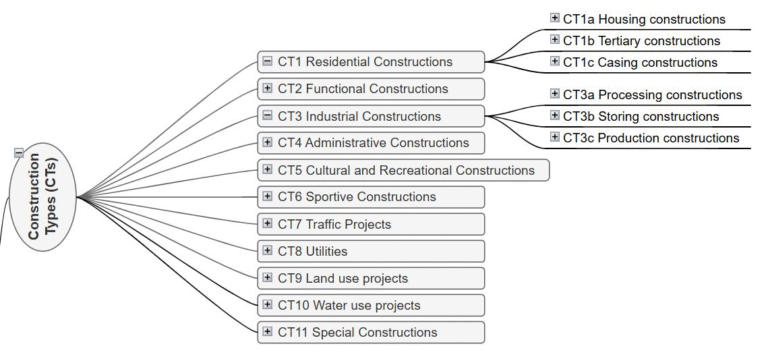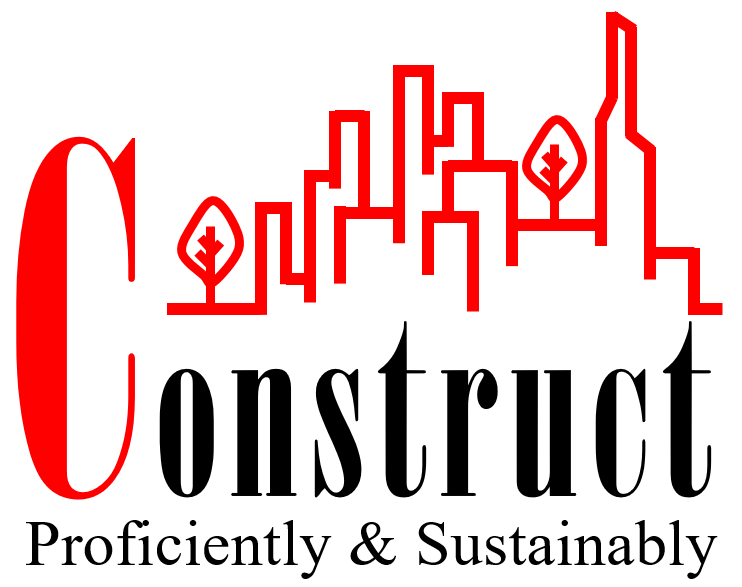A common misconception in discussions about construction investment is its narrow association with real estate or residential projects. In reality, construction is far broader and more diverse. Recognizing this diversity is critical for accurate investment analysis, strategic planning, and sustainability impact assessment. By moving beyond the “real estate = construction” mindset, we open the door to smarter investments, better risk management, and more targeted environmental strategies across the full spectrum of construction activities.

According to the Unified Classification System UniCCC, construction projects are organized into 11 distinct groups, encompassing much more than housing. These include:
1- CT1- Residential Constructions
are constructions that are occupied by individuals or families as dwellings and designed for comfort, privacy, and domestic activities. CT1 architectural style often reflects personal preferences and may have various designs but commonly include bedrooms, kitchens, and living spaces as principal part of the design. CT1 includes:
- CT1a housing constructions (e.g., Villas, collective housing, individual housing…),
- CT1b tertiary constructions (e.g., Hotels, resorts, hostels…),
- CT1c casing constructions (e.g., Military bases, prisons, summer camps, refugees’ camps, dormitories…).
2- CT2- Functional Constructions
are mainly devoted to ensuring the primary needs of the community that governments must build by either using their own funds or involving private bodies. Examples include offices, banks, hospitals, educational establishments, markets, religious buildings…
3- CT3- Industrial Constructions
refer to constructions dedicated to accommodating industrial processes for manufacturing, processing, or storing goods and materials (G&Ms). CT3 projects are commonly designed to ensure the efficiency of an industrial process and the fluidity its supply chain. Thus, they mainly include large open spaces, high ceilings, unloading/loading platforms and mechanisms to lodge machinery and facilitate reception, storage and delivery of used and produced G&Ms. Three divisions could be distinguished:
- CT3a processing constructions (e.g., cereals milling plants, milk-based products plants, bakery plants, fish and meat-based products plants, pharmaceutical laboratories…),
- CT3b storage constructions (e.g., logistic platforms, warehousing, waste disposals, energy storage platforms, cold storage platforms…),
- CT3c production constructions (e.g., power generation plants, ship and boat building yards…)
4- CT4- Administrative Constructions
consist of governmental and institutional facilities devoted to handling paperwork and coordination of various functions and carrying out managerial and organizational tasks to serve the population. Examples include courts, administrations, police stations, ministerial buildings, post offices…
5- CT5- Cultural and Recreational Constructions
are constructions dedicated to entertainment, relaxation and touristic purposes. They are essential, but do not have primary roles in the community. Those projects’ design gives high attention to finishes and spaces attractiveness. Examples include museums, theatres, entertainment buildings, religious buildings, wedding / conferences venues, restaurants…
6- CT6- Sportive Constructions
refer to facilities devoted to accommodating physical and recreational activities. Their design mostly includes playing fields, courts, tracks, seating for spectators, locker rooms, and specialized equipment depending on the nature of the sports they host. This group includes stadiums, gymnasiums, arenas, swimming pools …
7- CT7- Traffic projects
designate infrastructure and transit facilities devoted to enabling the movement and transfer of people and goods (P&Gs). CT7 projects are designed to improve connectivity between locations and ensure efficacy and fluidity of the P&Gs mobility. Earthwork, surfacing and coating of sizable linear and/or surfaces to bear high loads are the key focus of CT7 projects design and construction scopes. Among those we might cite roads, railways, subways, tunnels, bridges, highways, airports, seaports…
8- CT8- Utilities
consist of amenities and annexed kits devoted to providing all other construction types with basic services needed to ensure their functioning. They commonly involve long linear of trenching and underground grids. Examples include power supply, sanitation, gas supply, clean water supply, telecommunication (internet, phone and television) networks…
9- CT9- Land use projects
stand for open area projects involving exploitation of great surface of land for raw materials extraction, farming or archaeological purposes for instance. They comprise archaeological sites, nature reserves, agricultural farms, extraction quarries, livestock farms, national parks, zoos, managed forests, orchard, mines …
10- CT10- Water-use projects
stand for open area projects involving exploitation of great volume of water surfaces for water treatment, management or exploitation. They encompass dams, reservoirs, tidal barriers, fish farms, water control, pumping and/or retaining complexes, desalination and water treatment complexes …
11- CT11- Special Constructions
include non-common constructions that need sharp and/or specific expertise such as maritime oil platforms, astronomical observatories and nuclear platforms.
To Cite this Article
Bouhmoud, H., Loudyi, D., 2021. Building Information Modeling (BIM) Framework, Potential and Challenges. International Journal of Information Science and Technology 5, 24–35. https://doi.org/10.57675/IMIST.PRSM/ijist-v5i3.173
H. Bouhmoud and D. Loudyi, “Building Information Modeling (BIM) Framework, Potential and Challenges,” International Journal of Information Science and Technology, vol. 5, no. 3, Art. no. 3, 2021, doi: 10.57675/IMIST.PRSM/ijist-v5i3.173.
Bouhmoud, H., & Loudyi, D. (2021). Building Information Modeling (BIM) Framework, Potential and Challenges. International Journal of Information Science and Technology, 5(3), Article 3. https://doi.org/10.57675/IMIST.PRSM/ijist-v5i3.173
